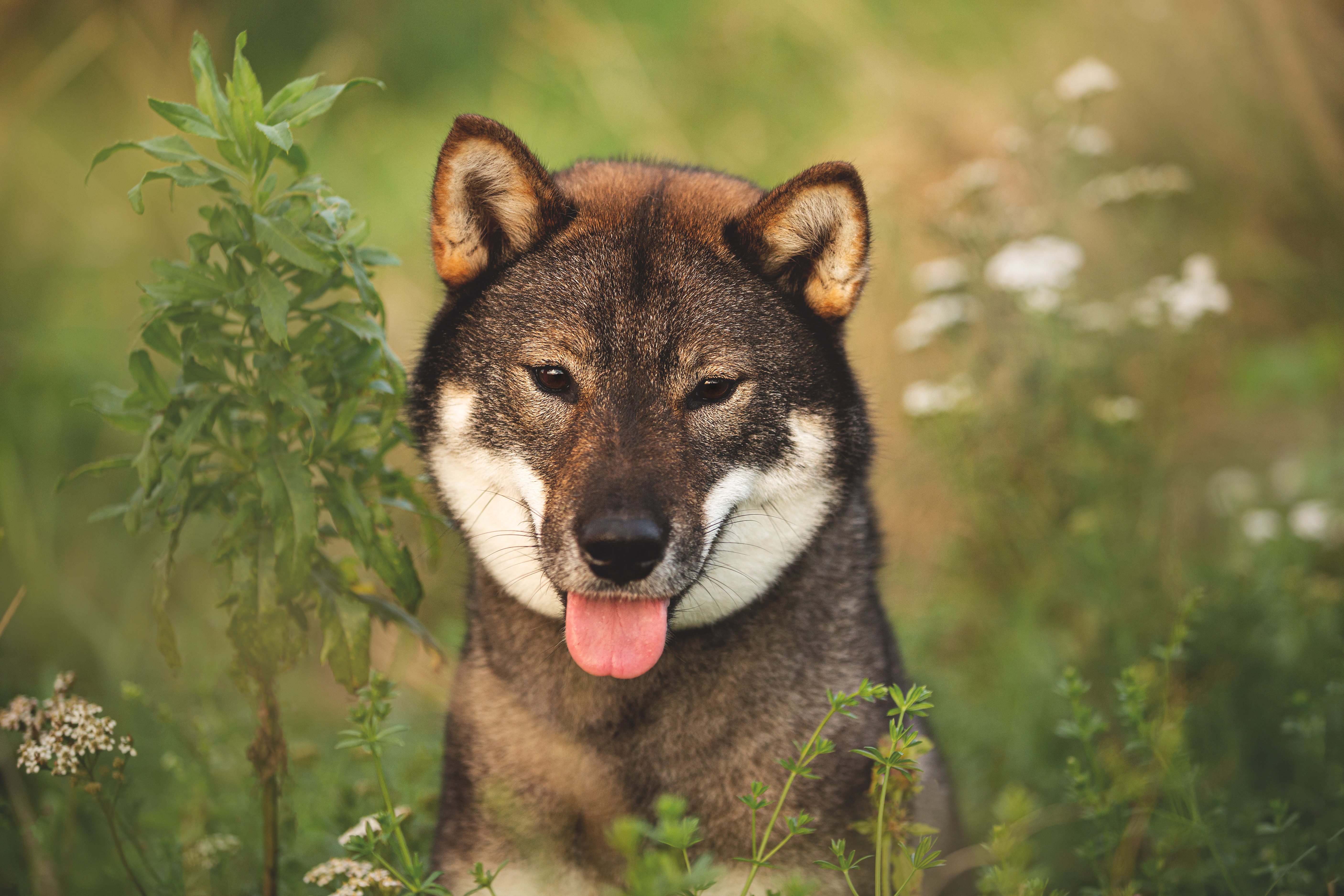
Shikoku preliminary results
UC Davis has been releasing preliminary breed reports once they feel that they have enough dogs to take a very initial look at a breed. Depending on the sample and how well those initial dogs were selected, it is possible they will represent a good snapshot of the breed. Of course, results will change some as more dogs are added.
So, what did UC Davis’ professor emeritus Dr. Niels Pedersen BS, DVM, PhD find in regard to the Shikoku in this preliminary analysis? The following article summarizes the full breed report written by Dr. Pedersen. You can find the full report here.
This report is based on testing of 27 Shikoku ken; chosen to represent unrelated bloodlines within the breed. While 27 individuals is not enough for a final analysis, it should give a good initial approximation of the status of the breed. We need more Shikoku from all around the world to be contributed, so please consider adding yours!
How inbred is the typical Shikoku ken?
A part the UC Davis canine diversity test is called Internal Relatedness or IR. This is an often used conservation genetics measurement that estimates how inbred a dog is. This measurement will range from 0 to 1 when a dog is more inbred, and from 0 to -1 when the dog is outbred. An outbred puppy would inherit genetics from its sire that were very different from those it inherited from its dam. An inbred puppy would inherit many of the exact same genetics from both its dam and sire. Being outbred reduces the likelihood of known and unidentified recessive component diseases expressing in individuals.
So, how inbred or outbred are the individuals in the Shikoku ken breed?
From the preliminary report:
The most inbred dogs had an IR score of 0.340, while the mean (average) IR score for the group was 0.015. One fourth of the population had IR scores between 0.105 and 0.340 and were significantly more inbred than the mean IR value (IR=0.015). In contrast, one fourth of the population had IR scores less than -0.075 to -0.194 and were significantly more outbred than the population mean (IR=0.015). Therefore, the population appeared to contain equal proportions of dogs that had parents that were as unrelated (most outbred) or related as possible (most inbred) given the genetic makeup of the population. The existence of both highly inbred and outbred individuals is a typical finding for almost all pure breeds of dogs tested at VGL.
…..
Almost all of the 27 Shikoku have IRVD values of 0.162 and greater (Table 4; Fig. 4) and if they were found today among village dogs, three-fourths of them would have IRVD scores >0.250 and be judged offspring of at least full sibling parents. Most of them would be even more related, with parents that are even more related to each other than siblings from a large and genetically diverse random breeding dog population. It is noteworthy that the IR graph (red line) is biphasic with the major population peaking at around -0.1 and a secondary population that peaks at around +0.15. This second peak represents the most inbred portion of the population. The fact that there are two peaks suggests what is called “population stratification.” Whether this stratification is an artifact resulting from how the test population was selected, characteristic of the breed in the USA, or typical of all contemporary Shikoku, will only be resolved with testing of more dogs from as wide a geographical area as possible.
Dr. Niels Pedersen 2019
To translate – the range of inbreeding in the breed is broad and there are roughly equal numbers of inbred and outbred dogs in the breed – however when adjusted by comparison to a very diverse breed, all Shikoku are very related and inbred. There is also a section of the population that appears to be highly inbred. Because we can’t necessarily detect where dogs fit into the population without DNA testing and analysis, or how to minimize further inbreeding in already inbred lines, this breed can benefit from predictive software aiding in selection of breeding mates, to insure that future breedings are not too close, risking health as a result.
How much biodiversity exists in the Shikoku Ken today?
Dr. Pedersen’s reports look at the data from the VGL canine diversity test in many different ways, in order to assess the total amount of biodiversity within a breed. Many of these measures together give us an overall picture of the state of the breed and as a result we can make informed decisions on breed management.
The best explanation I’ve yet read is from BetterBred Founder Natalie, and as a result we will share it again here!
Most breeders think of DNA as coming in two options- a good gene, or a mutant gene – like it is in many DNA tests. In fact, there are many genes or (in this case) markers that come in a great many variations – like a t-shirt that is available in different colors. The more variants there are, the more information we have about population genetics. In more inbred breeds, there are fewer variants for each marker. So an inbred breed might have only a few colors available in t-shirts, whereas a diverse breed will have many colors of t-shirts. Apart from the relatively small number of genes that make up specific, visible breed traits, the rest of the gene pool is generally healthier when there’s lots of variation.
Unfortunately when breeders select too strictly for too long for very specific traits, there can be an unintended loss of variation in the parts of the DNA that thrive with more variation. A good way to assess whether that good variation has been impacted is using the markers found in the VGL canine diversity test. Because they are considered neutral – or not associated with any specific known trait – they are great for assessing genetic diversity. In breeds with ample diversity, there will be lots of variations for each marker (lots of colors in the t-shirt drawer).
But what if you have a breed without much variation? Well, this happens, and can happen quite often. In this case the best thing breeders can do is try to make sure the variants that are in the breed are well distributed – so there are plenty of all of them in the breed. Imagine a t-shirt drawer with lots and lots of red t-shirts and only one blue one and one green one. If you lose one of the red ones, it doesn’t change much about the t-shirt drawer – there are lots of other red ones. But if you lose either the blue or green one, the variation is seriously diminished. If, on the other hand a third of the shirts are red, and a third are green and a third are blue, then it’s a lot harder to lose the existing variation in the drawer, even if you lose one once in a while and even though there are only 3 colors.
The Shikoku’s biodiversity
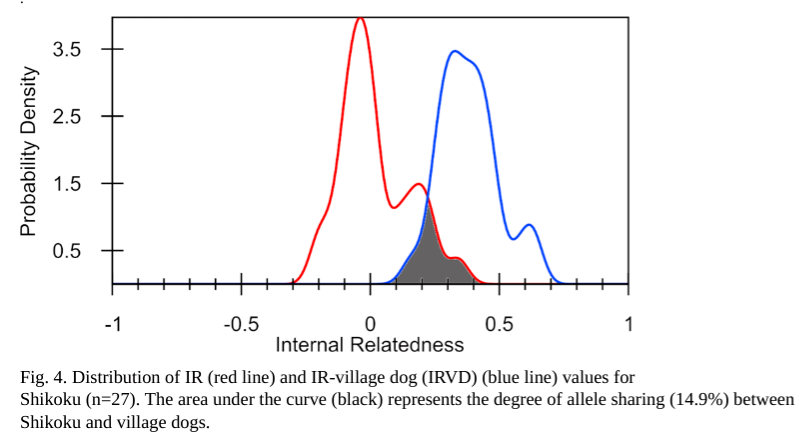
Another use of an individual’s inbreeding value (IR value): we can look at the inbreeding level of all individuals in the breed in aggregate – meaning the whole breed together. When a breed has had very few founders, or has had genetic bottlenecks in its history, whether from breeding practices or world events, it can mean, years later, that there is very little biodiversity left within the breed. By adjusting inbreeding values in comparison to the data from village dogs (often considered the “ideal” comparison), researchers can estimate the remaining biodiversity of a modern breed compared to the original diversity that once existed in dogs prior to breed formation.
So when this investigation was done, what did Dr. Pedersen see?
The darkened area in Figure 4 representing the overlap of IR and IRVD curves is an estimate of the amount (14.9%) of genetic diversity in present-day randomly breeding village dogs that still exists in contemporary Shikoku. This figure is about one-half the 26.5% retained canid genetic diversity for the breed that was determined from allele and allele frequencies of the 33 autosomal STRs (Tables 1, 2). Although both calculations are only estimates, and based on two different types of reference populations, it is reasonable to conclude that contemporary Shikoku have retained from 14.9-26.5% of the genetic diversity currently found in all canids. This loss of diversity has undoubtedly occurred over thousands of years of human selection (artificial genetic bottlenecks), which was slow at first but then rapidly accelerated over the last hundreds of years during which the breed rapidly attained its present appearance (phenotype). The greatest single genetic bottleneck for the breed was perhaps WWII.
Dr. Niels Pedersen 2019
This assessment indicates there is very little biodiversity in this breed, but let’s look at the data another way.

As mentioned in the quote above, another way to estimate the loss of biodiversity within a breed is to look at the average number of alleles found at each tested locus, and compare those to all the canine breeds thus far tested at UC Davis VGL. When looking at the number of alleles found, we consider two things: the average number of alleles found in total (Na = average alleles), and the average number of alleles that are effectively contributing to the population (Ne = effective alleles). Going back to the t-shirt analogy above, say we have 10 t-shirts…. 8 of them are red and one is green and one is blue. The total number of shirt colors is 3, however the majority color is red, therefore our “effective” t-shirt color would be only 1.
So, by looking at these numbers, what do we find out about this population?
The alleles identified in this group of 27 dogs (Na) represented 4.09 /15.4=26.5% of alleles known to exist at each of these loci in all canids tested at the VGL. Although this is higher than the Berger Picard (15.4%), it is somewhat lower than other small and less popular breeds such as the Swedish Vallhund (31.9%), Irish Red and White Setter (34.8%) and Flat Coated Retriever (38.6%); and considerably lower than popular and genetically diverse breeds such as the Golden Retriever (54.5%), Toy Poodle (55.6%) and Standard Poodle (58%).
Dr. Niels Pedersen 2019
The 27 Shikoku had an average of 4.09 alleles/loci (Na), but only 2.39/4.09=58% of the alleles were responsible for existing heterogeneity (heterogeneity=genotypic variation=phenotypic variation). This is typical for most pure breeds of dogs.
The estimate of remaining biodiversity left after breed formation using this method is only 26.5%. Additionally, Dr. Pedersen discovered that there is more diversity within the breed than is being effectively used. What do you do in the case of having diversity not contributing to the breed effectively? You identify individuals who may have unusual genetics for the population, and work to preserve those genetics and redistribute them in the population at large.
It is clear from both assessments that the Shikoku ken breed only has retained a small amount of the genetic variation compared to all other breeds analyzed thus far. Given that almost all the dogs sampled appear to not be closely related (see below), this lack of biodiversity is likely true for the breed as a whole.
These findings may change as more dogs are tested, and it is imperative for conscientious breeders to find and preserve any as yet unseen diversity in the breed. They can accomplish that first by testing as many dogs as possible, and keeping a keen eye out for healthy unusual or long isolated lines where perhaps there may be more variation.
Genetic Bottleneck evidence?
Based on the analysis of the markers from the report, there appear to be certain alleles that are over-represented at each tested marker. This lends some evidence that there is a potential genetic bottleneck in the breed and breeders will need to work to maintain the biodiversity that remains.
The average number of alleles per locus that have been discovered for all canids tested at the VGL is 15.4. Therefore, the most striking findings were the comparatively low number (3-6) of alleles found at each locus, and the high incidence of one or two alleles (Table 1). A single allele at two loci (FH248 and AHTh171-A) occurred 96 and 93% of dogs tested, respectively (Table 1). A single allele at four other loci (AHTk211, REN162CO4, REN64E19, VGL1063) was identified in ≥80% of dogs.
Dr. Niels Pedersen 2019
Breed relationships
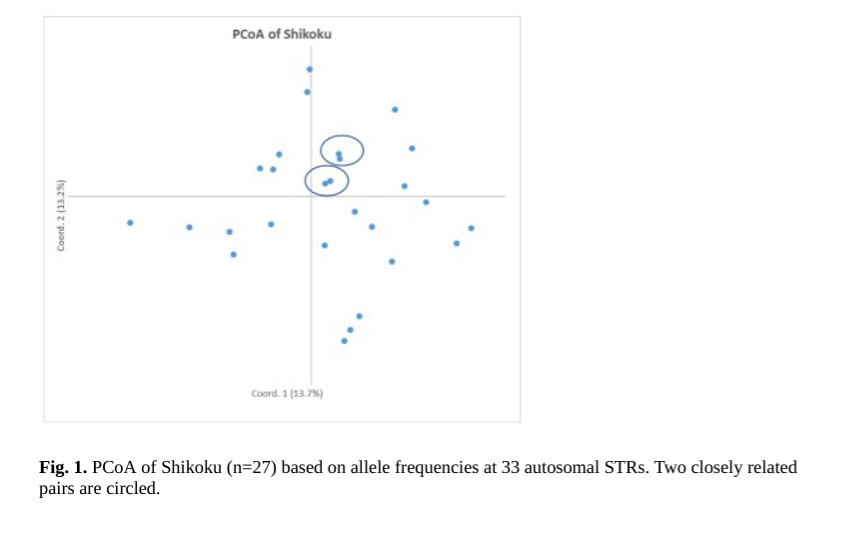
Another use of the data from the VGL canine diversity test is to see how the individuals within the population fit in relation to one another. What do we see when we look at this analysis, called the PCoA graph?
The Shikoku are purportedly one of the heritage Japanese breeds and may therefore be closely related to breeds such as the Japanese Akita and Shiba Inu. This relationship was studied in PCoA (Fig. 2). PCoA comparing the three breeds show them to be genetically distinct. When comparing genetically distinct breeds in PCoA, the relationship of individuals within a breed is made closer (i.e., it deemphasizes genetic differences). Although this enhanced clustering is more evident for the Shikoku in a three-breed comparison, the population is still reasonably dispersed (Fig. 2), as demonstrated in the single breed PCoA (Fig. 1).
Dr. Niels Pedersen 2019
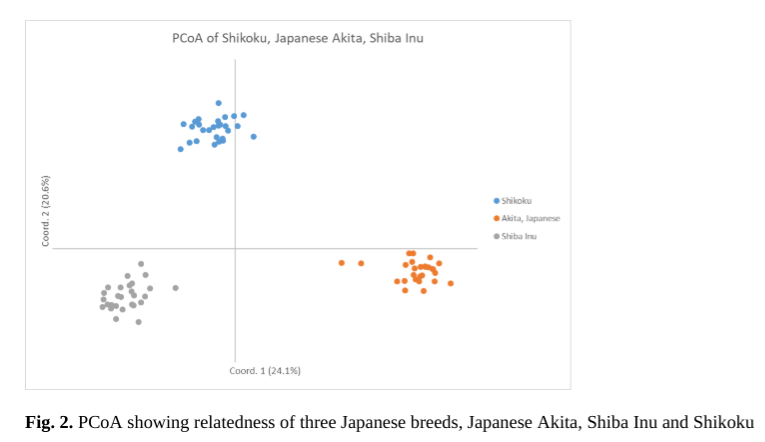
It appears the sample that has been collected thus far has included a broad sample of dogs from the Shikoku population, most of whom are as unrelated as possible.
What about when we compare the Shikoku ken with other Japanese breeds?
The Shikoku are purportedly one of the heritage Japanese breeds and may therefore be closely related to breeds such as the Japanese Akita and Shiba Inu. This relationship was studied in PCoA (Fig. 2). PCoA comparing the three breeds show them to be genetically distinct. When comparing genetically distinct breeds in PCoA, the relationship of individuals within a breed is made closer (i.e., it deemphasizes genetic differences). Although this enhanced clustering is more evident for the Shikoku in a three-breed comparison, the population is still reasonably dispersed (Fig. 2), as demonstrated in the single breed PCoA (Fig. 1).
Dr. Niels Pedersen 2019
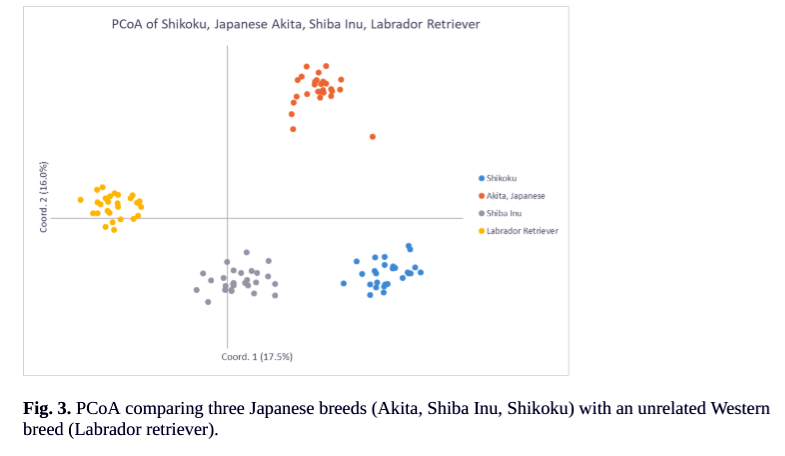
Additionally, the Japanese breed’s relationships can be further investigated by comparing them to other breeds. Dr. Pedersen chose to add the a more Western breed, Labrador Retrievers, to the PCoA. When this was done, it was apparent that the Shiba Inu and Shikoku are more closely related to one another than the Akita Inu.
In order to enhance the possible relatedness of these three Japanese breeds, a fourth unrelated Western breed, the Labrador Retriever, was added to the comparison (Fig. 3). In this comparison, the Shikoku and Shiba Inu breeds draw closer to each other in a single quadrant of the graph. This suggests that these two breeds are more closely related to each other than to Labrador retriever and Japanese Akita. This relationship is supported by significant sharing of a unique DLA class I/II haplotype (see section F). Interestingly, both Shikoku and Shiba Inu are more closely related to Labrador retrieves than to Japanese Akita.
Dr. Niels Pedersen 2019
The immune system
The UC Davis VGL canine diversity test can individually identify more regions of the DLA than any other test available today. The DLA, called Dog Leukocyte Antigen, is the region of the DNA that codes for the immune system in the dog. There are three regions, Class I, Class II and Class III. This test identifies both Class I and II haplotypes (a haplotype is a tightly linked group of genes within an organism that is inherited as a group from a single parent). To learn more about the DLA, read here.
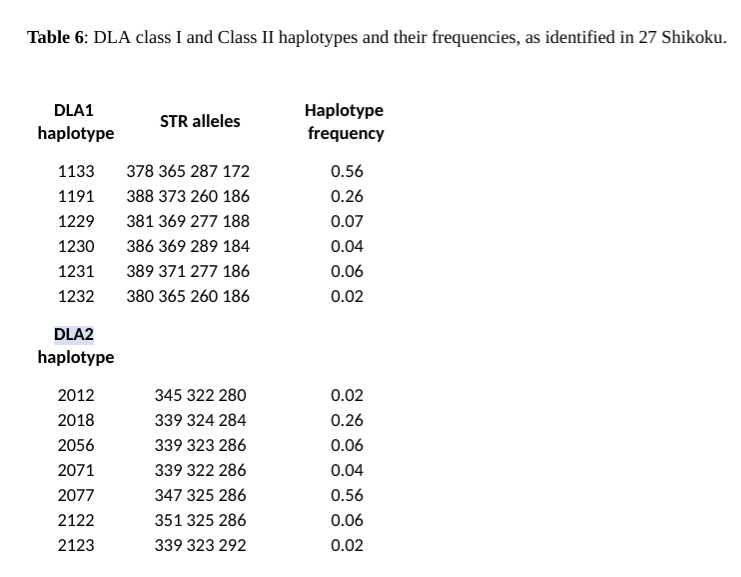
The 27 Shikoku that were tested possessed 6 DLA class I and 7 DLA class II haplotypes. This is higher than the Berger Picard (2, 2), similar to other small and less popular breeds such as the Swedish Vallhund (6, 4) and Shiloh Shepherd (7, 6), but lower than other breeds such as the Giant Schnauzer (14, 15), Samoyed (13, 12) and Shiba Inu (16, 15). These latter breeds were, in turn, much lower than popular breeds such as the Golden Retriever (26, 23) and Miniature Poodle (33, 23).
Dr. Niels Pedersen 2019
The breed possessed four unique DLA class I haplotypes (1229-1232) and two unique class II haplotypes (2122, 2123). The presence of so many unique DLA class I and II haplotypes is atypical for among the breeds which have been studied by VGL. Interestingly, the Shiba Inu also had a greater proportion of unique haplotypes.
Two DLA class I (1133, 1191) and two class II haplotypes (2018, 2077) were found in 82% of the dogs tested. Two class I and II haplotypes were in linkage disequilibrium forming extended 1133/2077 and 1191/2018 haplotypes. All of the remaining haplotypes occurred at low and almost equal frequencies. It would appear that these two extended haplotypes have been inherited by descent from two important founders or closely related founder lines.
As stated by Dr. Pedersen in his conclusion below, the lack of biodiversity in the DLA is worrisome. When more dogs are added to the study, there is possibility that more DLA haplotypes will be found. It also appears that the DLA region has suffered a genetic bottleneck within this breed with a disproportionate amount of tested haplotypes being the 1133/2077 and 1191/2018 haplotypes.
But what about these DLA haplotypes in other breeds? From Dr. Pedersen’s report: “The strongest sharing is of the extended DLA 1191/2018 haplotype with the Shiba Inu. This supports the distant relationship found with PCoA (Fig. 3). Only one DLA class I haplotype was shared with Shiba Inu and Havanese, while class II sharing, in addition to 1191/2018, was also with the Flat Coated Retriever, Havanese, Giant Schnauzer, Alaskan Klee Kai, Magyar Agar, Irish and Llewellin Setters, American and Japanese Akita, Golden Retriever, and the Poodles (Table 6).”
Conclusions
The following conclusions from Dr. Pedersen sum up the findings from the 27 Shikoku ken tested thus far.
The greatest problems with low genetic diversity often occur when a breed becomes popular, either for pets or shows, or both [9-11]. Popularity creates a rapid demand for new dogs, which in turn leads to less attention to proper breeding practices, and in particular overuse of certain sires. Likewise, showing often leads to subtle and not so subtle changes in interpretation of the breed standards and bouts of inbreeding to fix the desired trait [9]. Such changes often involve popular sires, but also popular dams and related bloodlines. If the gene pool is small, spontaneous mutations that often occur in areas of high selection pressures can be inadvertently swept up and amplified [9-11].
Dr. Niels Pedersen 2019
The lack of genetic diversity in the DLA class I and II region of these 27 Shikoku was noteworthy. It appears that two founders or founder lines have played an important role in the evolution of contemporary Shikoku. One of these founder lines is shared with the Shiba Inu, but not with Japanese or American Akita. It also appears that dogs that possess these haplotypes are possibly under some sort of positive selection, but whether that was due to non-random sampling or current inbreeding remains to be determined. A lack of genetic diversity in the DLA region is troublesome, but it is uncertain what it means, if anything, for the future of the breed. Certain DLA class I and II haplotypes have been associated with specific autoimmune diseases in certain breeds [8], but autoimmune disorders are not viewed as a serious problem for Shikoku. Therefore, the strongly shared DLA regions of the Shikoku do not appear to have a strong negative effect on self/non-self-recognition. Nevertheless, it is important that breeders maintain as much diversity and heterozygosity in the DLA region as possible.
………
Breeds that lack genetic diversity must be managed much more closely to avoid further loss of genetic diversity and have less leeway in dealing with simple recessive or complex polygenic disorders that might arise [10, 11]. Disease mutations are usually autosomal recessive in nature and frequently linkage with a region of the genome that is suddenly becomes subject to strong positive selection for a phenotype that is deemed desirable in the show ring [9-11]. Elimination of such deleterious mutations may result in loss of genetic diversity, especially when diversity is already limited [9-11].
While there appears to be little biodiversity within this breed, there appears to be little breed specific disease and the Shikoku enjoys relatively good health. For this reason, it falls on to breeders to maintain the genetic diversity that remains to prevent the rise of breed specific disease. While the DLA is also lacking in biodiversity, breeders should strive to maintain the DLA haplotypes present in the breed. UC Davis also demonstrated a clear ability to differentiate among the Japanese breeds, with an interesting observation of the closer relation of the Shikoku to the Shiba Inu than to the Akita Inu, while other studies have found difficulty in discerning the differences among these breeds.
Hopefully with further analysis and more dogs submitted to the study, more biodiversity will be found within the breed and successful management and conservation of that existing diversity can be enhanced.
 Previous Post
Previous Post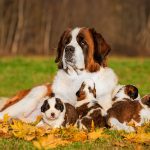 Next Post
Next Post


